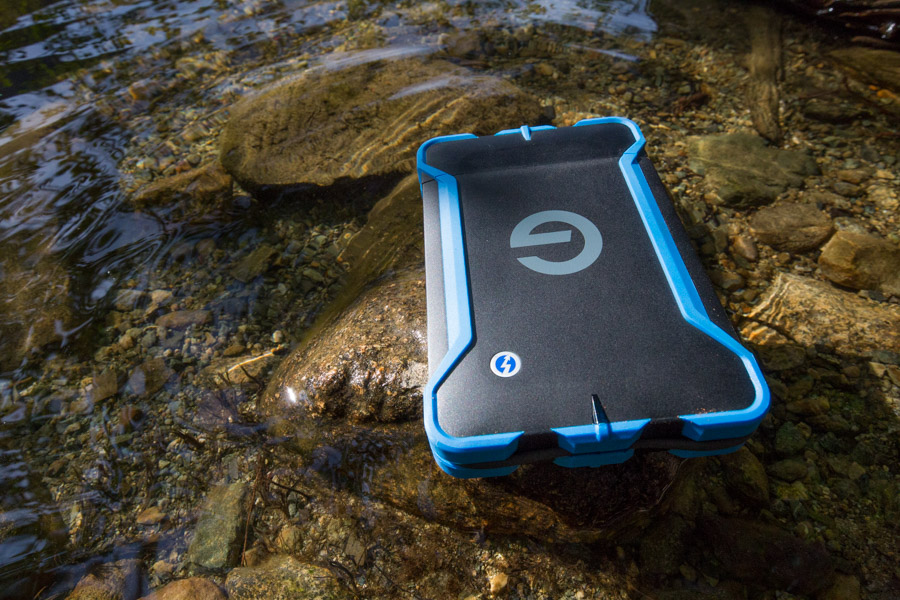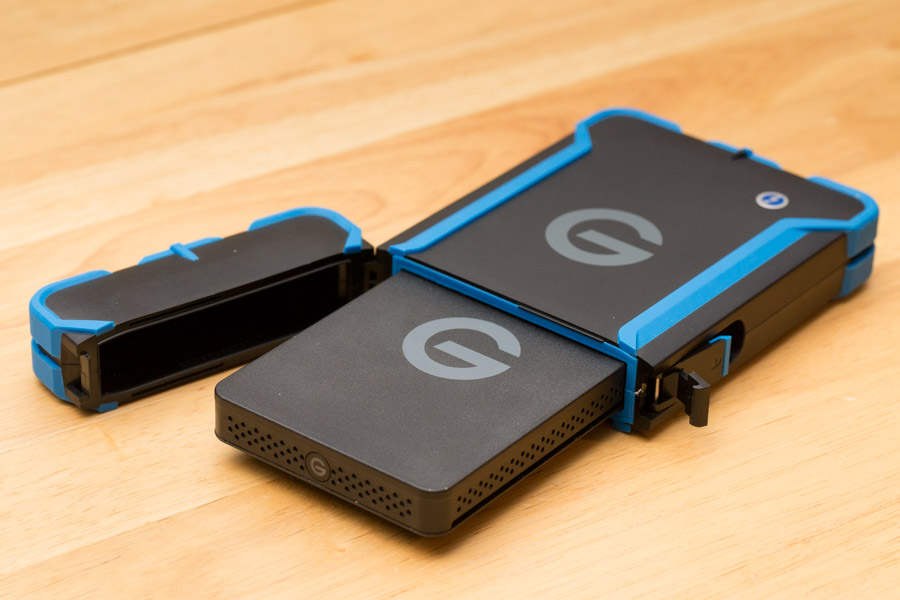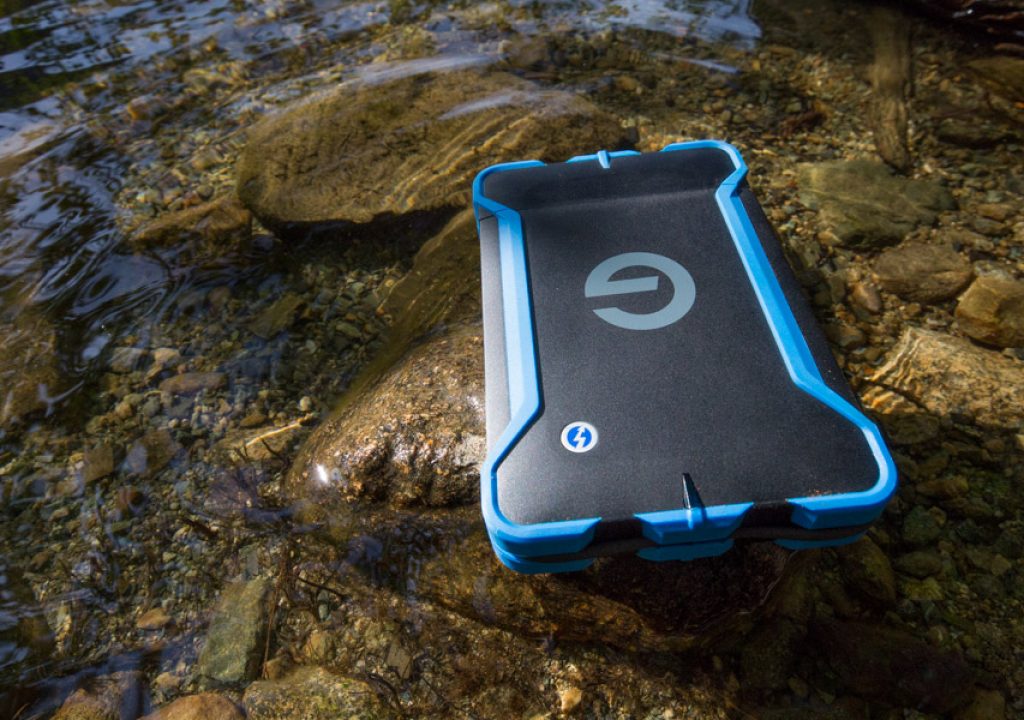G-Tech’s new Rugged hard drive lineup includes several different models to offer varying protection, and integration with their existing Evolution Series drives and dock. Dan tested out the G-Drive ev ATC to see how it stood up to the elements.

Earlier this year, G-Tech unveiled a new lineup of ruggedized hard drives that are designed to offer various levels of protection to your drives in the field. The new drives are part of G-Tech’s Evolution Series, which means that they are able to be inserted into the already-available G-Dock ev to create a simplified workflow when returning to your office after a shoot. The new G-Drive ev RaW takes the G-Drive ev that was already available, and puts it into a plastic casing to reduce 35% of the weight when compared to its metal predecessor. Then the whole thing is wrapped in a removable blue rubber bumper to increase the drop rating from 1.2m to 1.5m.
The second rugged option is called the G-Drive ev ATC, which is available with either a Thunderbolt connection or a USB3 connection. The ATC is a 2-part product, with the same plastic-cased ev RaW drive being inserted into a tough outer shell that has a built-in cable. Since the ev RaW drive has a USB3 connection on it already, even if you purchase the Thunderbolt version of the ATC, you still have a backup USB3 connection option if you just take the drive out of the hard ATC casing. I’m a big fan of drives that have built-in cables because since it gives you one less thing to worry about when it comes time to pack for a shoot. I’ve left cables behind before, but that’s a thing of the past now with companies like LaCie, Western Digital and now G-Tech all offering drives with captive cables. On drives that are designed for in-the-field use, it makes a ton of sense. Some people have commented to me, “what if the cable malfunctions in some way?”. To this, my answer is that I have forgotten more cables than I have ever had cables break on me. In the case of this ATC drive, you always have the backup option to use the USB3 port on the actual ev RaW drive inside the case, so it’s not something I’m ever going to worry about.

The G-Tech G-Drive ev ATC (who comes up with these names?!) is rated for drops up to 2m and also drops into water “of 1ft for 30 secs”. I suspect these 2m drop figures are quite conservative because the ATC case is built like a tank. To test water resistance, I first gently submerged the ATC in a sink full of water and left it there for some time. No water leaked in during that simple test. I wanted to find the limits though so I took the ATC to a lake and started dropping it from various heights and generally being a bit rougher with it. Some water did leak into the case at this point, so when it comes to resilience to liquid, I’d take G-Tech’s word and not exceed a 1ft drop for 30 seconds of water time. In other words, the ev ATC will save you from an accidental drop into water, but it’s not something that you could deliberately submerge and reasonably expect to have working afterwards. Since the Thunderbolt plug has only a basic rubber cap over it, this doesn’t keep it fully dry during a submersion either, so you’d want to watch out for possible corrosion of the terminals if you did keep getting it wet.
G-Drive ev RaW
What is puzzling to me is why G-Tech are not offering the aforementioned G-Dock ev without any drives in it. This is a pretty big deal for me, in fact it might have been a deal breaker as I sat playing with the ATC drive and mulling over a change in drive systems for my workflow. It’s all very well offering these new ev RaW and ev ATC drives for location photographers and videographers, but if I want to take full advantage of the full Evolution Series environment, I’m forced into purchasing two of the regular metal cased ev drives that come with the dock. I don’t want them! I want the dock for when I’m in the office and I want to buy several ev RaWs and ATCs for use in the field. With the dock + 2 regular EV drives coming in at $650, and single ev drives coming in at $150 each, it means I’m spending an unnecessary extra $300. Some of that annoyance might be negated if they start selling the ATC cases on their own, or the RaW rubber case on its own. Then, at least, I could take the regular metal ev drives into the field with me, albeit in the 35% heavier metal casing. It has been suggested that the ATC case will be available on its own, but no indication yet as to when that might be. Unfortunately it doesn’t appear that the rubber bumper of the ev RaW will be available as a separate purchase and I think that’s a mistake to not offer that option to existing owners of ev drives, or people that are forced to purchase them because they come with the ev Dock.
Another limitation of the Evolution Series environment is that the G-Drive ev, ev RaW and ev ATC all top out at 1TB in size. A 2TB ev 220 is available, but the drive is thicker and not compatible with the RaW rubber bumper or the ATC case. The ev 220 appears to actually be 2x1TB drives in a hardware RAID 1 stripe. This offers the speed boost of a stripe (up to 220MB/s claimed), but it’s a real shame you can’t have that as a rugged drive. My current setup sees me using the 2TB LaCie Rugged Thunderbolt drives and I do appreciate the 2TB size sometimes.
At this point, we might as well make a closer comparison to the LaCie Rugged drives because it is the obvious other option for people looking for in-the-field drive protection. I’ve personally used the LaCie Rugged drives my whole career, so I’m pretty familiar with them, and confident in their abilities to protect my drives in the sort of environments I travel to. LaCie only offer one level of protection; their Rugged drives are metal cases with a thick rubber bumper around the edges. On the other hand, G-Tech’s new line has two levels of protection as we’ve seen. The G-Drive ev RaW with the rubber bumper and its plastic casing offers less protection than a LaCie Rugged drive. The open sata connection on the back of the naked ev drives means it can’t match the IP54 water resistance rating of the LaCie Rugged Drive. Then we have the G-Drive ev ATC which sits at a protection level above the LaCie Rugged drives. Both the ATC and the LaCie Rugged are rated for drops of up to 2m, but the ATC drive can also be dropped into water, and from my hands-on experience, feels like a much more solid device than my LaCie drive. The downside of that added protection is the increased size of the drive. The comparative photos tell the story here; the ATC drive is quite a lot bulkier.
What I’ve always liked about the LaCie Rugged drives in the past is that there isn’t a lot of added bulk for the extra protection that you get. Whilst I often do find myself in places where their ruggedness can truly be an asset, I also don’t mind using them for day-to-day tasks where I have the protection simply as a safety net. The ATC case goes beyond this though. It is a noticeably larger bulk and footprint when I put it in my laptop bag or a pocket. I found myself wanting to remove the ev RaW drive from the ATC case for much of the time in day-to-day usage. For ultimate protection, the G-Drive ev ATC would be the best choice, but you must consider whether you truly need that much protection, specifically with regards to the water protection which is the main difference between the LaCie Rugged and the ATC. If you do not need that added protection, or the workflow benefits of the whole Evolution Series environment, then the LaCie drive might be a better option. The LaCie Rugged Thunderbolt is also available in 2TB hard drive size, or a 1TB SSD, neither of which are available in the G-Tech Evolution Series.
“But what about the speed?” I can hear you asking…
I tested the G-Drive ev ATC using AJA’s system testing tool as I do with all drives. The drive inside the ATC is a 7200rpm drive, and the drive inside the the LaCie Rugged drive is only a 5400rpm drive, so you’d think this should be a cakewalk for the G-Tech option. Wrong!
As I mentioned in my previous review of the LaCie Rugged Thunderbolt, not all 5400rpm drives are built the same. It is still the fastest 5400rpm drive I’ve ever tested and boasts an impressive read/write speed of around 140mb/s. The G-Drive ev ATC isn’t slow by any means, but the 7200rpm drive was only able to deliver an average read/write of around 130MB/s. That’s not slow, but it was definitely not as fast as the LaCie Rugged Thunderbolt.
Price-wise, things are pretty close. I’ve always considered G-Tech drives to be pricey in the past, but in this instance the options are very reasonable I think. The ev ATC with Thunderbolt (as tested) comes in at $230, where the LaCie Rugged Thunderbolt comes in at $190, both for 1TB versions of course. Considering the fact that the ATC is a totally seperate case, I think the price difference is to be expected. There’s also an ev ATC with USB3 coming shortly and that one will come in at $180. With the spinning drive speed being the bottleneck for speed, the USB3 ATC won’t be any slower than the Thunderbolt version and you could definitely argue that the more universal connection of USB3 is a useful thing, and a must if you’re a PC user.
If you just want the protection offered by the rubber bumper of the ev RaW, the 1TB drives only cost $129, which is really something of a bargain. Definitely not something I ever thought I’d say about a G-Tech product! This will still get you the same drive, and therefore the same 130MB/s read/write speed.
Ultimately, when it comes to G-Tech Rugged Vs. LaCie Rugged, it’s going to come down to how rugged you need your drive, or whether you need a 2TB size. The ATC offers heavier protection, and really, the drive speed difference is pretty negligible and not something that would affect my decision either way. Potentially the big win for G-Tech is the overall Evolution Series workflow environment. If you’re already a G-Dock owner, it’s a no-brainer to stick with the G-Tech options for your location work, I just wish they had a 2TB ATC option and an option to buy the G-Dock without the drives in it.
A good test with a review like this is whether I’m left wanting to buy the product at the end of it. I have to say that even after 10 years of using LaCie Rugged Drives, I do like the idea of these new options, when considered along with the use of the G-Dock as an office docking station. Had there been 2TB ev ATC options, and the option of an empty G-Dock, I’d probably have pulled the trigger right away. As it is, I’m going to think a little longer since it’s not long since I purchased my 2TB LaCie Rugged, but it’s a definite maybe…


